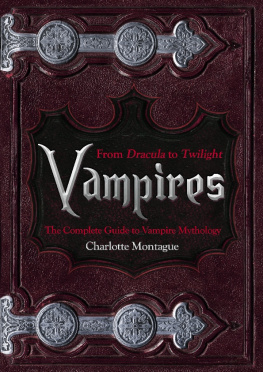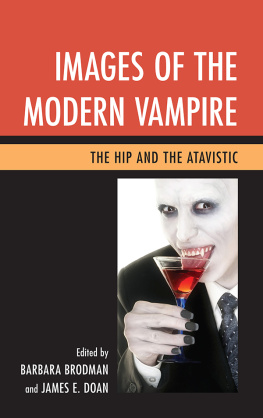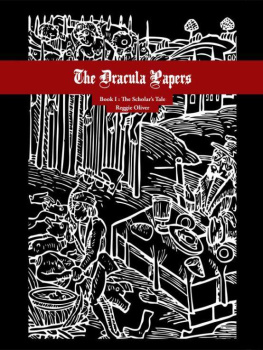Introduction

The legend of the vampire has never been more popular than it is today. Millions of copies of Stephenie Meyers Twilight series have been sold, and the vampire continues to be represented in many imaginative forms on stage and screen, whether in the theatre, in film, on TV, or in the field of popular music. On the internet, entire websites are devoted to the cult of the vampire, discussing details of lifestyle, dress and beliefs. In most cases, this fascination with the myth is harmless enough: it is simply a playful and enjoyable way for us to address some of our most confusing and difficult experiences in life, such as our fear of death, our longing for immortality, and our mixed feelings about becoming sexual beings as we grow up. However, there are instances in which the figure of the vampire attracts those with more evil intent, or those who suffer from various forms of mental illness. These are the individuals who take the legend literally, and begin to act accordingly: the devotees, past or present, known and feared for their bloodthirsty ways or their bizarre ritual practices.
In this book, we will be looking at all of these manifestations of the vampire myth, from its genesis in folklore to its status today as one of the most iconic figures in popular culture. We will try to find out how this strange creature, who came into being centuries ago as a minor figure in an obscure pagan belief system, that of the old religion of the Slavic countries, eventually managed to dominate the gothic imagination of the Victorians and beyond, in the process transforming itself from a hideous monster into the suave villain we know today.
The origins of the vampire legend go back centuries, to the dark forests of Transylvania, and the pagan beliefs of the Slavic peoples. They are shrouded in mystery, since the religious practices of these peoples were not written down, but we know that vampire folklore dominated the lives of rural peasants and priests during the Middle Ages. In particular, these communities were concerned with death and disease. At a time when medicine was in its infancy, and superstition was rife, the idea of the revenant, coming back from the grave to wreak revenge on the living, was highly potent, and struck deep fear into the largely uneducated population of the time.
Although Christianity had been introduced into these countries, peasant folk still retained their pagan beliefs. Among these was the idea that after death, the souls of those who had suffered in life, or who had committed crimes, were condemned to wander the earth for ever, alone and shunned by human society. This exclusion from love, and life, was thought to give the dead a deep resentment of the living, causing their spirits to rise from the grave as vampires. It was believed that these malign beings would make their way to villages and towns, bringing with them plagues and fatal diseases from the grave.
In the medieval imagination, the vampire was a vile, corpse-like being, swollen with blood and with its flesh rotting, whose revolting smell brought a foul pestilence into the streets where it walked at night, looking for victims. Today, this notion of the vampire as a lonely, reviled figure continues to be part of the myth. Other aspects of the medieval myth, such as the idea of the vampire as a bringer of plague from the dead, have become less important. This is perhaps because we now have access to medical science, and the process whereby the human body decomposes after death is better understood. The characteristics that so frightened the medieval peasant, such as bloating and swelling of the body, with fresh blood running out of the orifices, have been scientifically explained. In addition, the ways in which communicable diseases are spread are better understood, so that most of us no longer believe, when an epidemic breaks out, that a vampire may be responsible.
Over the centuries, the vampire myth originating from the Slavic countries began to spread throughout Europe, fuelled by tales of vampire sightings. In some cases, government officials were sent to quell panic in a remote area, only to come back with accounts of priests opening up graves to find bodies that had swelled and grown fat, with ruddy cheeks and blood running from their mouths, their hair and fingernails grown long while they sojourned underground. These sensational stories were reported in the newspapers, thrilling and horrifying the general population. In this way, the more literate classes of the eighteenth century began to become fascinated by vampires, and by the nineteenth, they had made their way into literature and art.
The vampire legend particularly appealed to the gothic taste of the Victorians, who revelled in tales of gloomy castles, northern forests, and evil ghouls lying in wait for innocent travellers. In this period, the most famous vampire of them all, Count Dracula, was born. He was the brainchild of Bram Stoker, whose refined, aristocratic bloodsucker caught the public imagination. Some cultural historians have argued that the figure of Dracula was a metaphor for the parasitic existence of the upper classes, and their dependence on poverty-stricken and brutally treated lower orders. Whether or not this was the reason for the Counts popularity, Stokers novel spawned a whole host of imitators, and in the twentieth century, went on to inspire new generations of artists, writers, and film-makers.
Todays vampire is a very different creature from the monster of the medieval imagination, or even the ghoulish aristocrat of Victorian horror stories. In modern novels and films, the status of the vampire as, on the surface, indistinguishable from normal human beings, is emphasized. Vampires are also characterized as having human emotions, that is, falling in love, feeling the pain of separation, loss, and vilification, and, most importantly, being anguished about their predicament as undead beings from the grave, excluded from human society and responsible for corrupting the lovers and friends with whom they form attachments. In this way, the modern vampire myth speaks to our ambiguous feelings about individuals who are, traditionally, excluded in our society: for example, drug users, people with unusual sexual orientations and the mentally ill. It also resonates with deep-seated fears, especially among young people, that passionate sexual feelings may arouse violence, and do harm to those we love.













.jpg)


